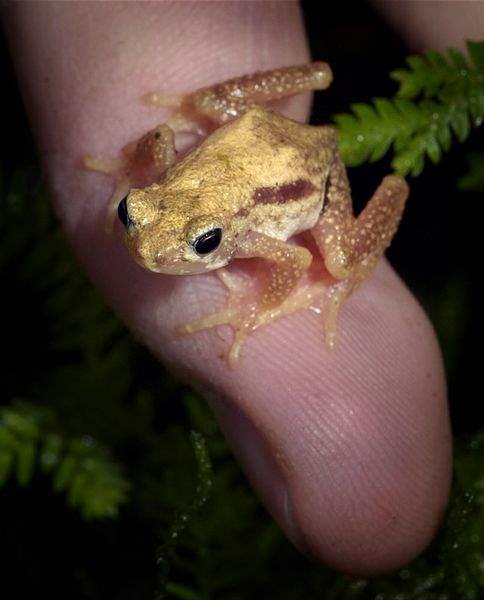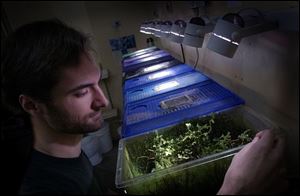
Spray toads make last stand
3/3/2004
A Kihansi spray toad, one of 24 at the Toledo Zoo and 74 in captivity in the world, rests atop Tim Herman s finger.
Morrison / Blade photo

A Kihansi spray toad, one of 24 at the Toledo Zoo and 74 in captivity in the world, rests atop Tim Herman s finger.
A tiny toad nearing extinction in the wild is making its last stand at the Toledo Zoo.
In a closet-sized room in the reptile house, keeper Tim Herman tends a makeshift cloud forest. His charges chirp happily as a steady mist spritzes their verdant homes.
These 24 Kihansi spray toads are the survivors, nearly the last of their kind. In January, a trip to their natal territory along the Kihansi River in Tanzania revealed the truth. From the tens of thousands first discovered in 1996, researchers found five.
“We saw one very skinny male, two females, and I heard two other males calling, said Sam Lee, of the Wildlife Conservation Society in New York.
Toledo Zoo is now home to one-third of the world s captive population. The other 50 captive toads soon will be at the Wildlife Conservation Society, the former Bronx Zoo. These two captive populations are the remnants of an ambitious restoration program now barely hanging on.

Zookeeper Tim Herman checks on the tiny toads' welfare.
“We might have avoided some of this if things were planned a little better in the beginning, Mr. Lee said. Lack of support for the breeding program at the start may condemn this last effort, he said.
It began in 2000, when zoos in Detroit and New York received a total of 538 toads from Tanzania. They hoped to establish a breeding population that could one day return toads to the wild.
Tanzania is a hard-pressed country. Its people are poor. The Kihansi River, with its 260-foot-high waterfalls and its torrent of water, was a natural resource. Damming it would provide electricity and, perhaps, prosperity.
In 2000, with a sizeable World Bank loan, the river was dammed and its flow diverted. Now a trickle of water drips into the gorge that was home to thousands of spray toads.
The animals had lived in a tiny paradise, their entire equatorial existence a gift of the mist rising from the cataract. Perfectly adapted for this small niche, the toads were devastated when it was cut off. They crowded along the edge of the river, surviving on the thinnest slice of their territory.
To save this remnant, narrow pipes sprayed the toad habitat with water. It worked for awhile. Toad numbers rose from a low of 2,000 to as many as 17,000 in 2003. Then disaster struck. A fungus that has slaughtered frogs around the globe invaded the Kihansi.
Meanwhile, the captive toads were dying too. They came from the wild with lungworms. Half the founding population died before veterinarians gained control.
Despite this, the animals bred vigorously. Nearly 700 were born at the Bronx Zoo.
“We got to the point where we were asking the [Tanzanian] government, which owns the toads, for assistance. We can t handle all of these. We did not have the ... resources to keep up, Mr. Lee said.
One hope was other zoos could take the overflow, Mr. Lee said. But the Tanzanian government deliberated nearly eight months before allowing the animals to go to other zoos. The Bronx Zoo turned off its misters in an effort to stop the breeding.
Finally, the Toledo Zoo, along with zoos in Oklahoma City, Baltimore, and Buffalo each received spray toads.
Toledo received 30 toads. All but seven died. Other zoos fared no better. In 2003, the same zoos received a second shipment. Toledo got 20.
Some of the zoos saw even those toads die. Oklahoma City lost all its spray toads. Detroit, which started with 250, lost all but five. Those five toads are now at the Toledo Zoo.
Toledo, though, has seen some success. First, there was dumb luck, Mr. Herman said. In looking for plants to carpet toad homes, he stumbled on the exact species of club moss the animals live with in Africa.
Then, there was success born of Mr. Herman s determination, said R. Andrew Odum, Toledo Zoo s reptile curator.
Looking at the skinny, fragile toads, Mr. Herman surmised the animals weren t getting the right light. Without proper ultraviolet light, the animals cannot metabolize calcium. In an extensive search, he sussed out the right bulb.
A World Bank representative said the institution plans to cover captive breeding costs at the zoos for at least six months, and possibly longer.
But even if money is forthcoming, success is far from assured, Mr. Lee said.
“This is our last-ditch effort. This is our Alamo. It s a little too late, basically, or maybe a lot too late.”